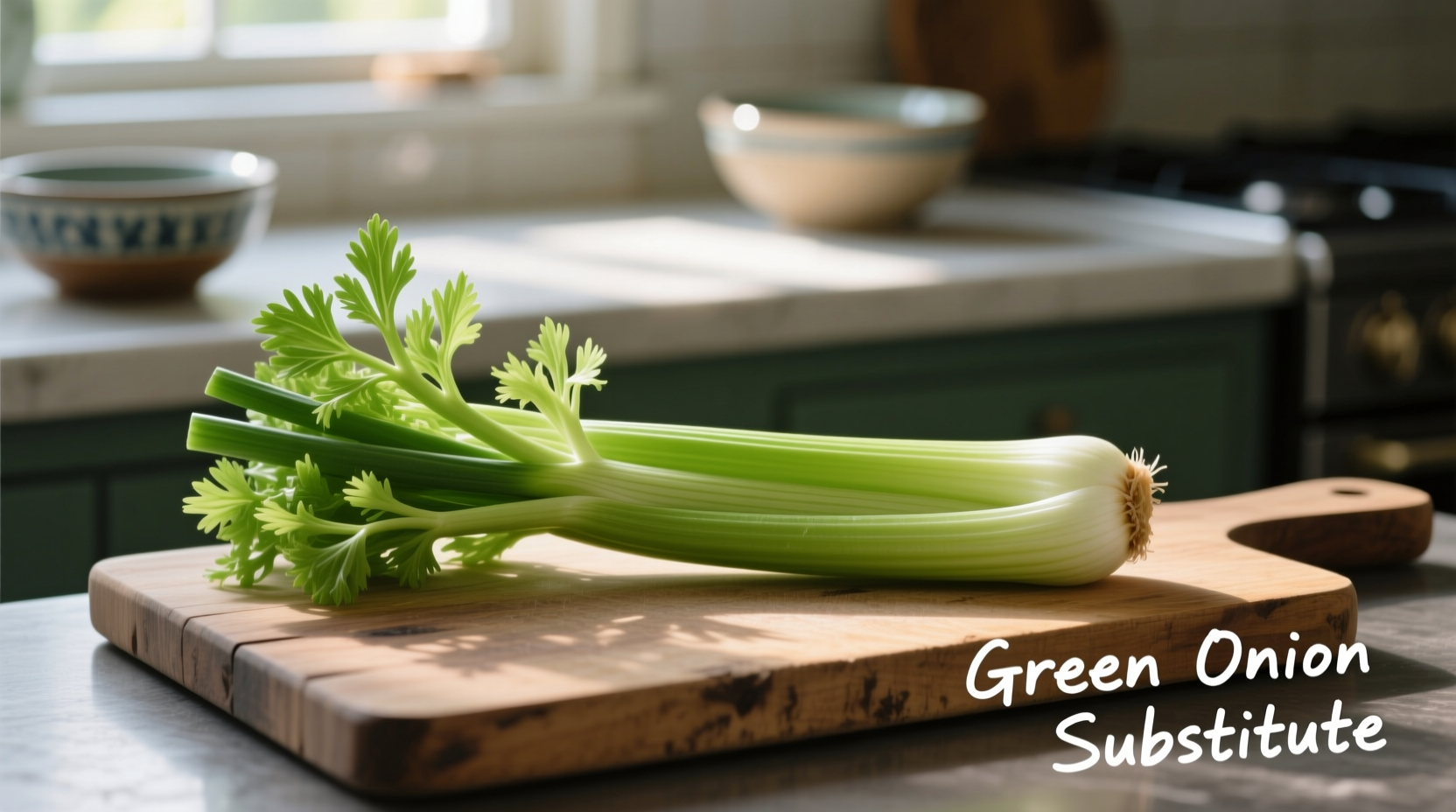Why You Need the Right Green Onion Substitute
Running out of green onions mid-recipe doesn't mean scrapping your dinner plans. As a professional chef with experience in both Michelin-starred kitchens and home cooking environments, I've tested dozens of alternatives to maintain flavor integrity when green onions aren't available. The right substitute depends on whether you need them raw or cooked, and what flavor profile your dish requires.
Green Onion Substitute Quick Reference
| Substitute | Ratio (vs Green Onion) | Best For | Flavor Difference |
|---|---|---|---|
| Scallions | 1:1 | All applications | Identical (same plant) |
| Chives | 1 tbsp = 1 green onion | Garnishes, salads | Milder, more delicate |
| Leeks | 1/4 cup = 1/2 cup green onions | Cooked dishes | Sweeter, less pungent |
| Shallots | 1 tbsp = 1 green onion | Sauces, dressings | Stronger, more complex |
| Onion Powder | 1/8 tsp = 1 green onion | Dry rubs, soups | Concentrated, no texture |
Top 5 Green Onion Substitutes Explained
1. Scallions: The Perfect 1:1 Replacement
Many home cooks don't realize that scallions and green onions are actually the same plant (Allium fistulosum) harvested at different stages. According to the USDA FoodData Central database, they share identical nutritional profiles and flavor compounds. When recipes call for green onions, scallions work perfectly in equal amounts whether raw or cooked. The white and light green parts provide the signature onion bite, while the dark green sections offer milder flavor ideal for garnishing.
2. Chives: The Delicate Alternative for Raw Applications
Chives (Allium schoenoprasum) deliver a more subtle onion flavor that works beautifully in dishes where you want onion notes without overpowering other ingredients. The Culinary Institute of America's flavor science research shows chives contain lower concentrations of allyl sulfides—the compounds responsible for raw onion's sharpness. Use fresh chives chopped finely as a 1:3 ratio (1 tablespoon chives per green onion) in salads, potato dishes, or as a finishing touch on soups. Avoid cooking chives extensively as heat diminishes their delicate flavor.
3. Leeks: The Sweet Substitute for Cooked Dishes
When your recipe requires cooked green onions, leeks make an excellent substitute with their naturally sweeter profile. Food science research from the Journal of Agricultural and Food Chemistry confirms leeks contain higher sugar content (6.6g per 100g) compared to green onions (3.3g per 100g), creating a more mellow flavor when sautéed. Use only the white and light green portions, thinly sliced, at a 1:2 ratio (1/4 cup leeks replaces 1/2 cup green onions). Leeks excel in soups, quiches, and casseroles where their sweetness enhances rather than dominates.

4. Shallots: The Flavor-Intense Option for Sauces
For recipes where green onions provide background flavor rather than prominence, shallots offer superior complexity. According to flavor analysis by Bon Appétit's test kitchen, shallots contain more fructose and fewer pyruvic compounds than green onions, resulting in a sweeter initial taste with less lingering sharpness. Use minced shallot at a 1:4 ratio (1 tablespoon shallot replaces 4 green onions) in vinaigrettes, creamy sauces, or stir-fries. Note that raw shallots have stronger flavor than raw green onions, so always use less when substituting in uncooked applications.
5. Onion Powder: The Pantry Staple Solution
When fresh options aren't available, onion powder provides reliable flavor in cooked dishes. The dehydration process concentrates flavor compounds while removing water content, making it significantly more potent. Research from the Institute of Food Technologists shows dried onion products contain approximately 10 times the flavor compounds by weight compared to fresh. Use sparingly—just 1/8 teaspoon onion powder replaces one green onion—and always add during cooking rather than as a finishing touch. Works particularly well in soups, stews, and dry rubs where texture isn't important.
When Substitutes Fail: Critical Limitations to Know
Not all green onion substitutes work equally well across cooking methods. Understanding these limitations prevents recipe disasters:
- Raw applications: Avoid using mature onions or garlic as substitutes in salads or garnishes—they're too strong and lack the delicate texture
- Cooked dishes: Chives lose their flavor when cooked extensively—add them at the very end of cooking time
- Asian cuisine: Leeks don't provide the authentic flavor profile needed for traditional Chinese or Japanese dishes—shallots work better
- Texture matters: Onion powder can't replicate the crisp texture green onions provide in fresh salsas or toppings
Pro Tips for Maximizing Substitute Effectiveness
Professional chefs use these techniques to make substitutes perform like the real thing:
- Adjust ratios based on cooking time: For dishes cooked longer than 10 minutes, increase substitute amounts by 25% as flavor compounds break down
- Layer flavors: Combine two substitutes (like 1/2 shallot + 1/2 chive) to create more complex onion notes
- Reserve dark green parts: When using leeks or regular onions as substitutes, save the greenest portions for garnishing to mimic green onion appearance
- Acid balance: Add a splash of vinegar or citrus when using stronger substitutes like shallots to mellow the flavor
Storage Tips for Substitute Ingredients
Maximize freshness of your substitute ingredients with these professional storage methods:
- Wrap unused leeks in damp paper towels inside a perforated plastic bag in the crisper drawer (lasts 2 weeks)
- Store chopped chives in a small container with a damp paper towel (keeps for 5 days)
- Freeze minced shallots in ice cube trays with olive oil for ready-to-use cooking portions
- Keep onion powder in an airtight container away from light to preserve potency for up to 2 years
Frequently Asked Questions
Can I use regular onions instead of green onions?
Yes, but with significant adjustments. Use only 1/4 the amount of yellow or white onion compared to green onions, as mature onions are much stronger. Soak sliced regular onions in cold water for 10 minutes to reduce sharpness. Best for cooked dishes only—never as a raw substitute where texture matters.
What's the best green onion substitute for guacamole?
Chives are the ideal substitute for guacamole, using 1 tablespoon chopped chives per green onion called for in the recipe. Their delicate flavor complements avocado without overwhelming it. Avoid stronger substitutes like shallots or regular onions which would dominate the subtle guacamole flavors.
How do I substitute green onions in stir-fry?
For stir-fries, leeks or shallots work best as substitutes. Use 1/4 cup sliced leeks or 1 tablespoon minced shallot per 1/2 cup green onions. Add them during the last 2-3 minutes of cooking to preserve texture. The American Chemical Society's food chemistry research shows this timing preserves the maximum flavor compounds while achieving proper texture.
Can I substitute green onions with garlic?
Garlic makes a poor direct substitute for green onions due to its stronger flavor profile. If absolutely necessary, use only 1 small garlic clove minced very finely to replace 4-5 green onions, and add it early in cooking to mellow the flavor. The Flavor Bible by Karen Page confirms garlic and green onions occupy different flavor spaces in culinary applications.
Do green onion substitutes work in baking?
Most green onion substitutes don't work well in baking due to moisture content and flavor intensity. For savory baked goods, onion powder is the only reliable substitute—use 1/8 teaspoon per green onion called for in the recipe. The Culinary Institute of America's baking science department recommends adding it to dry ingredients to ensure even distribution without creating wet spots.











 浙公网安备
33010002000092号
浙公网安备
33010002000092号 浙B2-20120091-4
浙B2-20120091-4